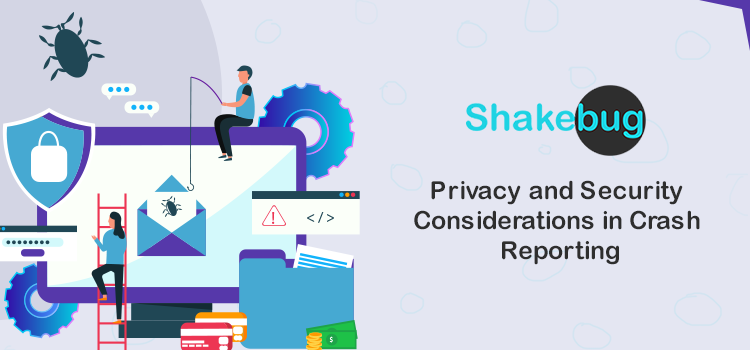Safeguarding user data in crash reports
When it comes to privacy and security considerations in crash reporting, safeguarding user data is of utmost importance. Companies need to ensure that all the information collected from users when a crash occurs is kept secure and not shared with any third parties without permission. This includes ensuring that only necessary data such as device type, operating system version, application version etc., are included in the report.
Additionally, companies should also consider encrypting their reports so that sensitive user data remains protected at all times. Businesses need to take these steps to protect their customers’ personal information while still being able to collect valuable insights about crashes which can help them improve their products or services over time.
Encryption and anonymization of crash data
When it comes to privacy and security considerations in crash reporting, encryption and anonymization of crash data are a must. Encryption ensures that the data collected from crashes remains secure while anonymization makes sure that any personal information associated with the reports is not shared or exposed. This helps protect users’ privacy by ensuring their sensitive information is kept safe and secure.
Additionally, this also prevents malicious actors from accessing confidential user data which could be used for nefarious purposes. By encrypting and anonymizing crash report data, companies can ensure they are providing an extra layer of protection when it comes to protecting their customers’ private information.
User consent and data transparency
User consent and data transparency are two of the most important factors when it comes to privacy and security in crash reporting. Companies must ensure that users understand what information is being collected about them when they use their product or service, as well as how this information will be used.
It’s also essential for companies to provide clear opt-in/opt-out options so that users can control which types of data they share with a company. Additionally, companies should make sure that all personal data collected is stored securely and only accessed by authorised personnel.
Get real-time alert with best crash reporting tool
Compliance with data protection regulations
Companies need to ensure that their data protection regulations are being complied with to protect the safety and integrity of user data. This includes ensuring that all collected information is stored securely, encrypted if necessary, and only accessed by authorised personnel.
Additionally, companies should have a clear policy on how long they will store this sensitive information as well as what measures they take to delete or anonymize any personally identifiable information after its use has been completed.
GDPR and crash reporting: What developers need to know
With the introduction of GDPR, developers need to be aware of how it affects crash reporting. The privacy and security considerations for collecting data from users must now be taken into account when developing applications that use crash reporting.
Developers should ensure they have a clear understanding of what information is being collected, who has access to it, and how long it will be stored before taking any further steps in implementing crash reporting systems.
By following these guidelines, developers can help protect both themselves and their users while still providing valuable insights through crash reports.
Navigating HIPAA compliance in crash reporting for healthcare apps
Navigating HIPAA compliance in crash reporting for healthcare apps is an important consideration when it comes to privacy and security. Healthcare organisations must ensure that any data collected from their applications are kept secure, as well as comply with the regulations set forth by the Health Insurance Portability and Accountability Act (HIPAA).
This includes taking measures such as encrypting patient information, limiting access to only authorised personnel, and ensuring proper disposal of all records containing protected health information. Additionally, companies should also consider implementing a system for tracking crashes within their application so they can quickly address any issues or vulnerabilities found.
Minimising data collection for privacy
One way to minimise data collection for the sake of privacy is by using a combination of techniques such as obfuscation, encryption, and tokenization.
Obfuscation can be used to hide sensitive information from view while still allowing developers access to necessary debugging data.
Encryption ensures that any collected data remains secure even if intercepted by malicious actors.
Tokenization allows for the replacement of personally identifiable information with randomly generated tokens which cannot be reversed back into their original form without authorization.
By utilising these methods in tandem, companies can ensure that user’s data remains safe and private during crash reporting processes.
Collecting only essential data for effective diagnostics
When it comes to privacy and security considerations in crash reporting, collecting only essential data for effective diagnostics is key. This means that any collected data should be limited to the information necessary to diagnose a problem or identify an issue with a product or service. Any unnecessary personal data should not be included as part of the report.
Additionally, all collected data must be securely stored and protected from unauthorised access. By following these guidelines, companies can ensure their customers’ privacy while still being able to effectively troubleshoot problems when they arise.
Balancing data collection with user privacy concerns
Companies need to collect enough data to identify the cause of crashes, but they must also be mindful of their users’ privacy concerns. Companies need to ensure that any collected data is kept secure and not shared with third parties without explicit consent from the user.
Additionally, companies should consider anonymizing or aggregating sensitive information before sharing it with other entities. By taking these steps, businesses can protect user privacy while still gathering valuable insights into potential issues within their software products.
Secure transmission and storage of crash reports
For a company or organisation to ensure the safety of their data, they must use secure methods when transmitting and storing any type of sensitive information. This includes using encryption protocols such as TLS/SSL (Transport Layer Security/Secure Sockets Layer) to protect data while in transit, as well as ensuring that all stored data is encrypted at rest.
Additionally, companies should also consider implementing access control measures such as multi-factor authentication and role-based access controls so that only authorized personnel can view or modify crash report data. By taking these steps organizations can help keep their customer’s personal information safe from malicious actors looking to exploit vulnerabilities within an application’s codebase.
Implementing secure protocols for data transmission
Implementing secure protocols for data transmission is a must to protect the privacy of users’ information. This includes using encryption, authentication, authorization, and access control mechanisms, as well as other measures such as firewalls and intrusion detection systems.
Additionally, organisations should also consider implementing policies that ensure only authorised personnel have access to sensitive user data. By taking these steps towards protecting user’s personal information from unauthorised use or disclosure, companies can help maintain trust with their customers while still providing valuable insights into system performance through crash reports.
Best practices for securely storing crash reports on servers
Privacy and security considerations are important when it comes to crash reporting. Best practices for securely storing crash reports on servers must be followed to ensure the safety of user data. This includes encrypting all stored information, limiting access only to authorised personnel, and regularly monitoring server logs for suspicious activity.
Additionally, organisations should consider implementing a system-wide policy regarding how long crash reports will be kept before being deleted or archived so as not to store unnecessary amounts of sensitive user data over time.


